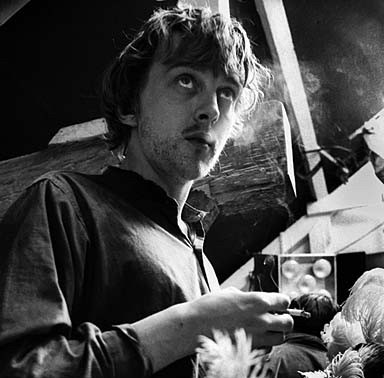Read Time 6 minutes
Hamish Roberton’s Points Estate zine
LA-based photographer Hamish Robertson likes his work to tread the line between real and imaginary – and I’ll be honest, when I was introduced to his newest personal project, Points Estate, I struggled to tell the difference.
A piece of autofiction accompanied by a series of haunting photo collages, Points Estate imagines a visit to a secluded corner of Northern England, inhabited by two reclusive artists and their monumental sculptural work set within the rugged landscape, who are finally ready to share their work with the world via Robertson’s lens.
It’s a romantic narrative that is easy to get swept up in, and the images are wholly convincing in their strangeness. Oh my God I wish this place was real. I spoke to Hamish over email about the zine.

How did you arrive at the concept of Points Estate? You imagine it as a secret location and closed to the public?
I had the opportunity to stay in a small cottage in England’s Lake District back in 2016 and took to exploring the countryside and losing myself in the landscape with my camera. A handful of the areas I visited really overwhelmed me in their immediately peaceful isolation, yet they were all actually quite close to the region’s towns and villages. I hatched the idea of an unseen beauty––a collection of sculptural works both at odds with and in harmony with their surroundings––almost hiding in plain sight, so I created Points Estate as a place where monuments could stand on display, but only for those willing to look for them.
You describe the characters of the artists Castroe and Vallum as ‘reclusive’ … did you have a sense of why they might prefer to keep their work private and within the confines of their own land?
They’re a metaphor for the patience and creative frustration experienced when making a series of photographs, but also the hesitation one can feel when sharing work.


You’re an LA-based photographer but it’s clear from this project that your roots are in the north of England, the images are very sensitive to the landscape. I wonder how both places have influenced your work?
There’s certainly, at times, a similarity of natural light in Los Angeles and the north of England. In the moments when the Southern California sun is hidden or diffused it frequently reminds of the daylight of my childhood in Yorkshire. Having not lived in the United Kingdom for almost 20 years I have the luxury of seeing it anew each time I visit. It becomes clear how much of the natural beauty I took for granted when living there. It serves as a reminder to both explore and document it more when I have the opportunity to visit but also to not overlook the mundane or everyday vistas and environment around where I live now in Los Angeles.
Can you tell me more about the autofiction element of this zine?
It’s autofiction as visual collage. When I took the landscape photographs in 2016 I was imagining these structures, sculptures, and embedded shapes and could seem them clearly as I captured the frames, but had to ponder how to make them come to life and in what format, and as with fiction or nonfiction, how I could structure that narrative both in visuals and text.

You ‘visited’ Points Estate and took the photographs back in 2016, but the zine has just been released now. Why the wait?
As I alluded to in the previous question, it’s a mix of patience and frustration. I knew I wanted the sculptures to be monumental in scale but also natural in texture. I have made previous photo collage series magnifying small gems, crystals, and rocks, recomposing them and playing with scale, so I had originally set about finding natural found objects that I could shoot and collage into the landscape. However, only a few work from those early experiments particulatly spoke to me so I’ve been going back and forth with these images for years. In that time the technology has caught up with the idea in a technical way but also conceptually — I knew what each sculptural shape was to be and it since they were only in my head, to communicate them I’d either have to merely describe them, so it’s a beautiful irony that today’s evolving technologies enable an artist to create through description and have the results live in harmony with handmade work — and the ultimate creators of those results will remain as unknown as Castroe and Vallum.
END
All images courtesy of Hamish Robertson.
Follow Hamish on Instagram here, and discover more from Points Estate here.
subscribe for the latest artist interviews,
historical heronies, or images that made me.
what are you in the mood for?









